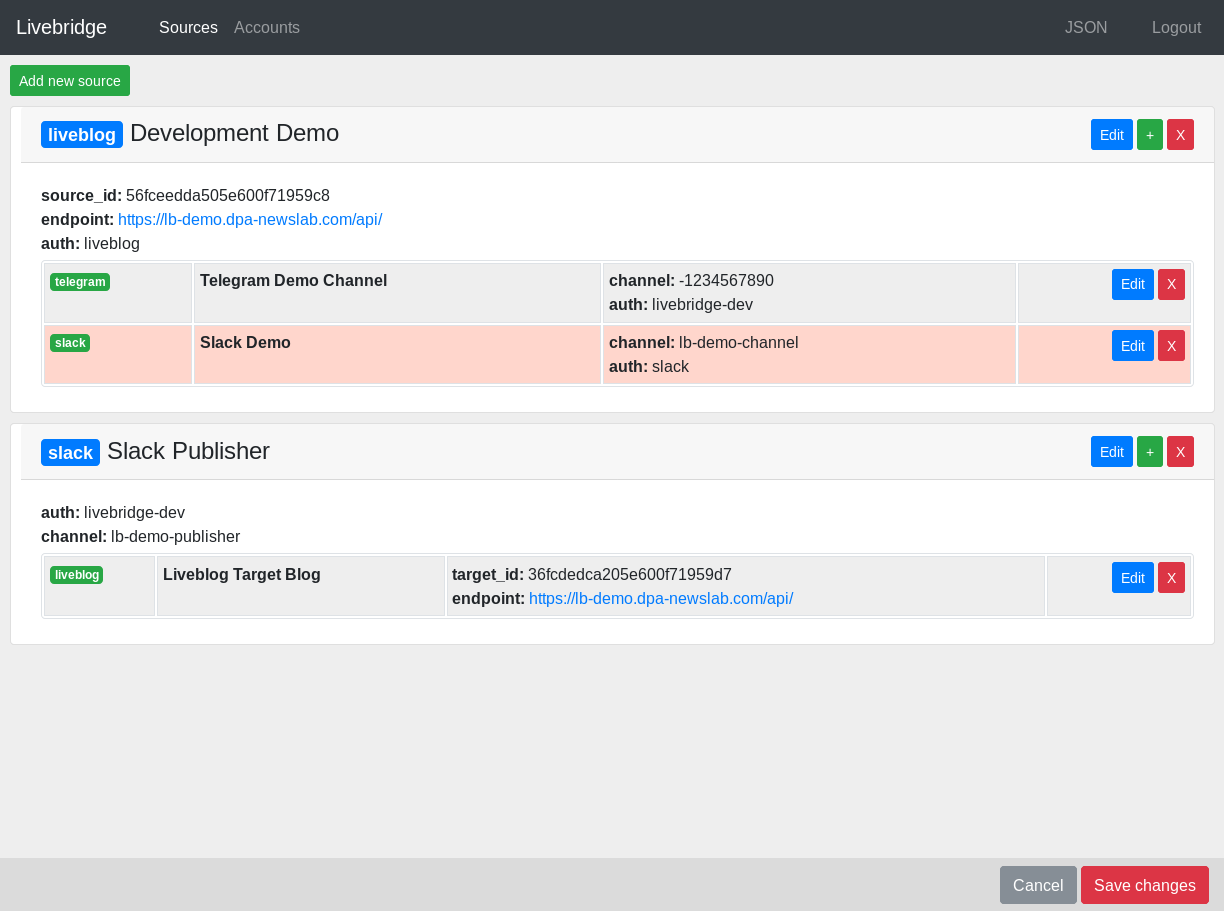Control bridges¶
The bridges will be specified by extra control-data, which can be stored in an extra .yaml control file or as JSON in a database table.
This control-data ca be edited directly or via a web-frontend.
Control bridges via web-UI¶

- Setup Web-API
- Open the adress http://[LB_WEB_HOST]:[LB_WEB_PORT]
- You’ll be asked for username and password, which have been declared via LB_WEB_USER and LB_WEB_PWD.
- Fill in the authorization credentials for your sources and targets under the Accounts tab.
- Specify the bridges and targets you want to connect under the Sources tab.
- Existing sources and targets can be edited too.
- Changes at existing data will be highlighted in red.
- To store the modifications made, click the Save changes button in the bottom bar.
- Alternatively convert your existing yaml-formatted controlfile to JSON and paste it under JSON in the textarea and save it.
Note
Please use unsecured http:// connections only while in development. Securing the connection to the web-UI via https:// is highly recommended!
Control data in .yaml file¶
The livebridge command expects a -control= parameter or alternatively the LB_CONTROLFILE environment var. It specifies the path to a control file with the configuration for the content bridges.
–control / LB_CONTROLFILE can be either a local control file or a remote control file on s3:
- with local control file
livebridge --control=/path/to/control.yaml
- with remote control file on S3
livebridge --control=s3://bucketname/control.yaml
- with remote file on S3, specified via environment variable
LB_CONTROLFILE=s3://bucketname/control.yaml livebridge
The bridges, over which the content is syndicated, are setup in this control file in YAML format. Use control.yaml.example as basis for your own control file.
auth:
dev:
user: "dev"
password: "pwd"
api_key: "F00Baz"
live:
user: "prod"
password: "pwd2"
api_key: "Foobar"
bridges:
- source_id: "abcdefg"
endpoint: "https://example.com/api/"
label: "Example 1"
targets:
- type: "scribble"
event_id: "123456"
auth: "dev"
- type: "another"
event_id: "654321"
auth: "live"
- source_id: 54321
endpoint: "https://foo.org/api/"
label: "Example 2"
targets:
- type: "scribble"
event_id: "123456"
auth: "dev"
Control data stored in database¶
The configuration for bridges can also be saved in the database storage used. This can be either a SQL-based database supported by SQLALchemy or AWS DynamoDB.
The name of the table has to be specified by an environment var, either by LB_DB_CONTROL_TABLE (SQL) or LB_DYNAMO_CONTROL_TABLE (DynamoDB). The table will be created, if it does not exist.
The data is stored as JSON and looks correspondent to the example above the following way:
{
"auth": {
"dev": {
"user": "dev",
"password": "pwd",
"api_key": "F00Baz"
},
"live": {
"user": "prod",
"password": "pwd2",
"api_key": "Foobar"
}
},
"bridges": [
{
"source_id": "abcdefg",
"endpoint": "https://example.com/api/",
"label": "Example 1",
"targets": [
{
"type": "scribble",
"event_id": "123456",
"auth": "dev"
},{
"type": "another",
"event_id": "654321",
"auth": "live"
}
]
},{
"source_id": 54321,
"endpoint": "https://foo.org/api/",
"label": "Example 2 - deactivated",
"active": false,
"targets": [
{
"type": "scribble",
"event_id": "123456",
"auth": "dev"
}
]
}
]
}
Authorization¶
Credentials for service authorization are defined under auth, in which the keys like dev or live are later used for reference under bridges and targets.
ENV-var notation for service credentials¶
It’s possible to hide credentials from the control-data by using a special ENVIRONMENT variable notation to specify credential values.
By using a notation like env.LB_*, values in auth credentials can be imported from the environment the livebridge process is running in.
auth:
dev:
user: "env.LB_DEV_USER"
password: "env.LB_DEV_PWD"
api_key: "env.LB_DEV_API_KEY"
live:
user: "prod"
password: "pwd2"
api_key: "Foobar"
bridges:
....
Note
Only notations, following the mandatory form env.LB_VARNAME, are recognized.
Handling of changed control-data¶
When using a SQL-based storage-backend, a running Livebridge process is constantly checking in the background for changed control-data.
If a change is detected (means the control-data of a bridge was altered, removed or added), the running process will start, stop or restart the specific bridge(s).
Note
You can define the interval (in seconds) for this check by setting LB_POLL_CONTROL_INTERVAL. Default is 60 seconds.
Local control files aren’t checked for changes automatically. By setting LB_CONTROLFILE_WATCH to true, this check can be forced.
When using DynamoDB as storage-backend, an AWS SQS queue has to be used for signalling changed control-data. This queue can be configured via LB_SQS_S3_QUEUE.
Bridges¶
One or more bridges can be controlled under bridges:.
Mandatory for every source or target is type, which is a string and has to match the values of livebridge.base.BaseSource.type or livebridge.base.BaseTarget.type of the described concrete source or target plugin.
Two optional, but recommended properties are label and active. label should contain a descriptive string, with active you can deactivate single bridges by making active: false.
All configuration values besides type will be turned over to the concrete target and source classes as __init__ parameter config.
If there’s an auth value for the source or target, the value will be matched to a block under auth and these values will be merged under auth of the source/target. For example the last target from the example above will be resolved from Livebridge to following Python dict structure:
{
'type': 'scribble',
'label': 'An example.',
'active': true,
'event_id': '123456',
'auth': {
'user': 'dev',
'password': 'pwd',
'api_key': 'F00Baz'
}
}
Sources¶
A block for a source consists of parameter for the source and one or multiple targets blocks.
Targets¶
A block for a target consists of parameter for the target.
